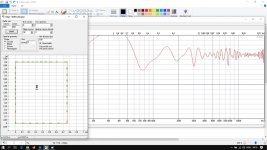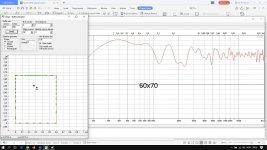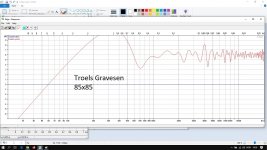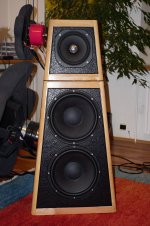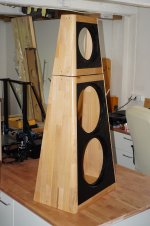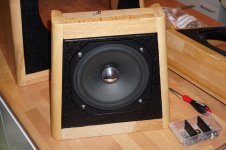I've got an Open Baffle project going and I'm using The Edge software to get an idea of which baffle size to use.
I have plenty of OSB-boards at hand so I made baffles 76x90 centimeters (30x35"). Size were chosen at a whim without
checking with The Edge.
They sound nice on all kinds of music I've played so far: Classical, Jazz, vocals, instrumental etc.
Some recordings/instruments make the speakers disappear and the sonic signature does not change if I walk into the
next room. These speakers must be doing at least something right.
I got curious and entered the measurments into The Edge and here's the result:
See left pic.
In order to make OB's a little more wife-friendly I looked at baffles 60x70 centimeters (24x28").
Here's the result in The Edge:
See center pic.
As can be seen, the graph for the smaller baffle has much less peaks and dips compared to the larger ones.
I'm no expert and I'm not sure I really understand what I'm looking at, but aren't less peaks and dips a good thing?
Troels Gravesen who made the OBL15's chose a size of 85x85 centimeters (33x33") and I checked the response for his
baffles. After all, Troels seems to know a thing or two about OB-speakers.
Here's the response, (right pic).
As can be seen, the response resembles that of my own large baffles with the greater peaks and dips.
So,- I know that these graphs should be taken with a grain of salt,-but how important are they?
Should I aim for as flat a response as possible or will the OB's sound OK despite having the larger peaks and dips?
After all, my larger OB's seem to do quite well soundwize.
I have plenty of OSB-boards at hand so I made baffles 76x90 centimeters (30x35"). Size were chosen at a whim without
checking with The Edge.
They sound nice on all kinds of music I've played so far: Classical, Jazz, vocals, instrumental etc.
Some recordings/instruments make the speakers disappear and the sonic signature does not change if I walk into the
next room. These speakers must be doing at least something right.
I got curious and entered the measurments into The Edge and here's the result:
See left pic.
In order to make OB's a little more wife-friendly I looked at baffles 60x70 centimeters (24x28").
Here's the result in The Edge:
See center pic.
As can be seen, the graph for the smaller baffle has much less peaks and dips compared to the larger ones.
I'm no expert and I'm not sure I really understand what I'm looking at, but aren't less peaks and dips a good thing?
Troels Gravesen who made the OBL15's chose a size of 85x85 centimeters (33x33") and I checked the response for his
baffles. After all, Troels seems to know a thing or two about OB-speakers.
Here's the response, (right pic).
As can be seen, the response resembles that of my own large baffles with the greater peaks and dips.
So,- I know that these graphs should be taken with a grain of salt,-but how important are they?
Should I aim for as flat a response as possible or will the OB's sound OK despite having the larger peaks and dips?
After all, my larger OB's seem to do quite well soundwize.
Attachments
Last edited:
emtor, your sim has only the tweeter's response and distance is 100 meters! Tweeter plays typically above 2kHz...
I suppose you want to see simulation for bass driver? Set speaker diameter and place it on the baffle where you want and place the mic on center of it. Set Mic distance to 3-5 meters.
Save the first measurement and move the mic sideways 0.5 meters, save the response and move to 1m, save and then move 1,5m Now take screeshot and save it.
Then change baffle size and repeat previous procedures. Etc.
Then compare the responses containing off-axis responses!
Biggest difference that baffle dimensions make is the frequency of dipole peak and first null. Narrow baffle has dipole peak at higher frequency. Very narrow has also sparper peak and null. Placing the speaker offset from centerline helps with secondary etc. peaks and nulls a little.
Modern dipole design use variable baffle width - as wide as possible for bass, about 20cm for mid and minimal/no baffle for the tweeter. Troels's OBL doesn't follow that! Design should aim to get even dipole radiation pattern in as wide band as possible.
LX521 Description
I suppose you want to see simulation for bass driver? Set speaker diameter and place it on the baffle where you want and place the mic on center of it. Set Mic distance to 3-5 meters.
Save the first measurement and move the mic sideways 0.5 meters, save the response and move to 1m, save and then move 1,5m Now take screeshot and save it.
Then change baffle size and repeat previous procedures. Etc.
Then compare the responses containing off-axis responses!
Biggest difference that baffle dimensions make is the frequency of dipole peak and first null. Narrow baffle has dipole peak at higher frequency. Very narrow has also sparper peak and null. Placing the speaker offset from centerline helps with secondary etc. peaks and nulls a little.
Modern dipole design use variable baffle width - as wide as possible for bass, about 20cm for mid and minimal/no baffle for the tweeter. Troels's OBL doesn't follow that! Design should aim to get even dipole radiation pattern in as wide band as possible.
LX521 Description
Last edited:
You will find that as the "size" (e.g. longest dimension) of the baffle exceeds about twice the diameter of the driver's radiating surface the on and off axis responses (which you don't seem to have simulated yet) will start to have peaks and dips, may cross, and do other undesirable things, primarily in the frequency region above the dipole peak.
Larger baffles move the dipole peak down, and have less dipole cancellation losses at lower frequencies.
Smaller baffles move the dipole peak up, but suffer from greater cancellation losses at lower frequencies.
Unless the baffle is under the 2x size rule, expect some issues on and off axis to happen, to one extent or another.
I have built systems in which all drivers have no baffle (sometimes called nude mounting) to make the on and off axis responses as smooth as possible. But this makes the crossover difficult to implement without DSP and you often need at least a 3-way or 4-way system because the bandwidth for each driver must be smaller to minimize the sensitivity loss in the lower part of the passband. So it is up to you (the designer) to choose your path. A large OB system is possible and many have received rave reviews, so it is about tradeoffs and what you feel is important for your speaker system to do well.
Larger baffles move the dipole peak down, and have less dipole cancellation losses at lower frequencies.
Smaller baffles move the dipole peak up, but suffer from greater cancellation losses at lower frequencies.
Unless the baffle is under the 2x size rule, expect some issues on and off axis to happen, to one extent or another.
I have built systems in which all drivers have no baffle (sometimes called nude mounting) to make the on and off axis responses as smooth as possible. But this makes the crossover difficult to implement without DSP and you often need at least a 3-way or 4-way system because the bandwidth for each driver must be smaller to minimize the sensitivity loss in the lower part of the passband. So it is up to you (the designer) to choose your path. A large OB system is possible and many have received rave reviews, so it is about tradeoffs and what you feel is important for your speaker system to do well.
Juhazi --> Perkele! 😱
You're right. I opened up the Edge and realized the speaker size box says millimeters. I mistakenly took it for centimeters.
Thanks for spotting the error.
I'll do as you advice for my Coral Flat 8's. (8 inch fullrange) with several baffles on and off axis.
CharlieLaub --> Good advice . . . I'll check out the behaviour for on and off axis.
You're right. I opened up the Edge and realized the speaker size box says millimeters. I mistakenly took it for centimeters.
Thanks for spotting the error.
I'll do as you advice for my Coral Flat 8's. (8 inch fullrange) with several baffles on and off axis.
CharlieLaub --> Good advice . . . I'll check out the behaviour for on and off axis.
Hi Emtor,
You may try a trapezoid baffle as well, aiming at a smaller baffle width where the Corals sit and a larger baffle width for the bass driver. Folding back the lower part of the baffles, tapered to the top, will lead to better WAF and larger apparent baffle width for the bass.
The photos below show a compromise baffle, quite small, and working fine.
All the best
Mattes
You may try a trapezoid baffle as well, aiming at a smaller baffle width where the Corals sit and a larger baffle width for the bass driver. Folding back the lower part of the baffles, tapered to the top, will lead to better WAF and larger apparent baffle width for the bass.
The photos below show a compromise baffle, quite small, and working fine.
All the best
Mattes
Attachments
A trapezoid is worth a try as I've got lots of OSB sheets.
As for WAF,-no problem. My wife doesn't care as long as the sound is better than what comes out of our flatscreen TV.
As for WAF,-no problem. My wife doesn't care as long as the sound is better than what comes out of our flatscreen TV.
Hi Emtor,
Your flatscreen TV is most probably not only sounding bad by itself, but will also make your speakers sound worse than they are...
All the best
Mattes
Your flatscreen TV is most probably not only sounding bad by itself, but will also make your speakers sound worse than they are...
All the best
Mattes
- Home
- Loudspeakers
- Full Range
- Open Baffle & The Edge software
